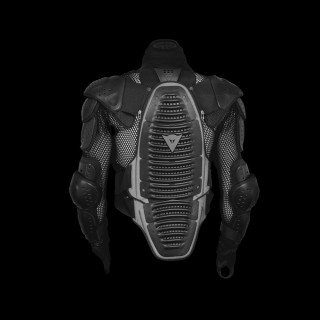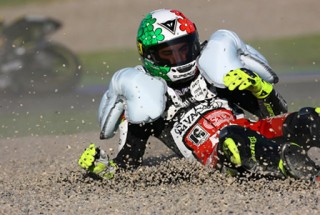- Manufacturer: Dainese
- Material: polyethylene, nylon
- www.dainese.com

Index
- Dainese Dainese, an Italian company founded in 1972 by its current President Mr Lino Dainese, started out as a manufacturer of Motocross leather pants. Since
- Advancements Humans have been wearing armour for thousands of years. By the 1400s, armour in the Western world had become highly sophisticated. With the right armo
- Airbags The biggest advancement in riding safety since leather jackets and full-face helmets - Inflatable Active Protection. A huge video screen left little r
- Biomimicry Biomimicry is a field that replicates on a molecular level new materials and technology by applying what was learned from the marvels of nature found
Dainese, an Italian company founded in 1972 by its current President Mr Lino Dainese, started out as a manufacturer of Motocross leather pants. Since its beginning, the company's history has been intertwined with that of legendary riders who have made motorcycling history: from Giacomo Agostini, Barry Sheene, Freddy Spencer, Kenny Roberts and Kevin Schwantz in the FIM Road Racing Championship to Edi Orioli and Franco Picco in the Paris-Dakar off-road race, champions were wearing Dainese gear as far back as the 1970s. Today, the tradition is carried on by the most illustrious names in motorcycling like Valentino Rossi, Max Biaggi, Jorge Lorenzo, Marco Simoncelli and many others.
Back Protection
You'd never thought of it before. Then someone proposes a shell that protects your back and says it's going to save you. That's not really easy to believe, right off the bat.
Yet Lino Dainese succeeded in convincing first MotoGP racers and then World Cup skiers to wear his Back Protector. That made it the red devil company's symbol: a product that cuts across lines and exports Lino's original concept of safety and protection from the world from the race track to the ski slope by way of snowboards, kite-surf, and mountain bikes.
Once again, the story of the birth of the first back protector for motorcycle riders is a result of the technical sponsorship of MotoGP racers.
Lino listened to the racers, especially those like Barry Sheene who were looking more to the future. He had a hunch, and discussed it with Marc Sadler, the most significant designer in Dainese history. Marc thought of the armadillo, flying insects that fall to ground and get up without a wince. A spinal shell: that was the idea.
Barry Sheene was interested and believed in Lino Dainese right from the start. He'd already broken enough bones as it was, risking his life at 250 km/hour on the Daytona track when a tire burst. He also knew the fine line between life and death was almost invisible because it lies hidden just beneath the surface. The back protector immediately seemed like the right solution.
Mother Nature inspired the shape of this remarkable innovation with the armadillo's jointed corazza more than the lobster's shell a masterpiece of biomechanical engineering. Human protection developed through Medieval and Renaissance armour that offered protection, ergonomics and safety to the privileged few. Created by ingenious craftsmen, they were extremely expensive, and reserved to only the most wealthy.
This is the challenge today: transform concepts inspired by nature and the most brilliant ideas in history in order to create protectors to be offered to the widest number of users possible.
Democracy has finally come to the world of protection.
Dainese may be known for its luxe motorcycle helmets and leathers, but the Italian company recently displayed two pieces of decidedly futuristic apparel at the 2008 Legend of the Motorcycle Concours d'Elegance.
In anticipation of NASA's down-the-road Mars landing missions, Dainese has teamed up with MIT for an ambitious project that intends to pressurize an astronaut's body without the usual bubble of air that creates bulky spacesuits. We've seen the suit concept before, but bringing on these bike gurus is just cool - and smart.
Ditching the old-school 'Moon Man' image, Dainese's futuristic space duds feature a fitted design strung with intertwining black-and-gold filaments. It may look like a sleek bodysuit by Armani, but the filaments actually serve a crucial purpose: They run along Lines of Non Extension (LoNEs) on the human body, which according to chairman Lino Dainese 'remain stationary even when we move. If these points are united,' he explains, 'the same pressure is established throughout the body.'
Oddly enough, Dainese insists that this concept of 'adherent suits' originated in the 1950s, but was abandoned because prototypes were too stiff. While the suit has been in development for several years, Dainese hopes the suit will be used when NASA finally sets foot on the Red Planet sometime around the year 2030.
Humans have been wearing armour for thousands of years. By the 1400s, armour in the Western world had become highly sophisticated. With the right armour, you were nearly invincible.
All that changed with the development of cannons and guns in the 1500s. You can increase the thickness of traditional armour materials, but they soon become too cumbersome and heavy for a person to wear. It wasn't until the 1960s that engineers developed a reliable bullet-resistant armour that a person could wear comfortably.
Modern body armour is divided into two main categories: hard body armour and soft body armour. Hard body armour, made out of thick ceramic or metal plates, functions basically the same way as the iron suits worn by medieval knights: it is hard enough that a bullet or other weapon is deflected.
Typically, hard body armour offers more protection than soft body armour, but it is much more cumbersome. Police officers and military personnel may wear this sort of protection when there is high risk of attack, but for everyday use they generally wear soft body armour, flexible protection that you wear like an ordinary shirt or jacket.
Kevlar
In 1969, American Body Armor was founded and began to produce a patented combination of quilted nylon faced with multiple steel plates. 'The Barrier Vest' was the first Police vest to gain wide use during high threat Police operations. In the mid-1970s, DuPont introduced Kevlar synthetic fiber, which was woven into a fabric and layered. Kevlar body armour could be comfortably worn by police daily, and would save lives.
In 1975 Richard A. Armellino, the founder of American Body Armor, marketed an all Kevlar vest called the K-15, consisting of 15 layers of Kevlar that also included a 5" X 8" ballistic steel 'Shok Plate' positioned vertically over the heart and was issued US Patent #3,971,072 for this innovation.
In 1976, Richard Davis, founder of Second Chance Body Armor, designed the company's first all-Kevlar vest, the Model Y.
By the mid to late 1980s, an estimated one third to half of Police patrol officers wore concealable vests daily. By 2006, more than 2,000 documented police vest 'saves' were recorded, validating the success and efficiency of lightweight concealable body armor as a standard piece of everyday Police equipment.
Shear Thickening Fluid
The University of Delaware and the U.S. Army Research Laboratory have collaborated to produce a novel technology for improving the protective properties of fabrics.
The liquid called 'shear thickening fluid' is actually a mixture of hard nanoparticles and nonevaporating liquid. It flows normally under low-energy conditions, but when agitated or hit with an impact it stiffens and behaves like a solid. This temporary stiffening occurs less than a millisecond after impact, and is caused by the nanoparticles forming tiny clusters inside the fluid. The particles jam up forming a log jam structure that prevents things from penetrating through them.
The stiffening of the liquid allows the energy of an impact to be distributed over a much larger surface area – so the force, rather than being focused on the area of a bullet head, is distributed over the area of the surrounding fabric
'We can make thin layers of material for use on the arms and legs that remain flexible under normal motion, but become rigid and absorb energy when impacted by a ballistic threat or a knife' says Norman Wagner from the University of Delaware
There could also be many civilian applications – like protecting people during car crashes, or making tires sturdier.
The biggest advancement in riding safety since leather jackets and full-face helmets - Inflatable Active Protection.
A huge video screen left little room for imagination. As an ill-fated test dummy crashed violently into a static car, a set of three impressive-looking air bags inflated from within the riding vest and formed a huge air cushion around the dummy's upper body and helmet. And it all happened within 30 milliseconds... well before the rider had parted ways with the machine.

Biomimicry is a field that replicates on a molecular level new materials and technology by applying what was learned from the marvels of nature found through the amazing functions of a particular organism. Most of the standout products of synthetic fiber research, such as nylon (an attempt to replicate silk) and polyester (an attempt to replicate cotton) are milestones in the history of biomimicry.
Dinosaur Eel
Scientists seeking to protect the soldier of the future can learn a lot from a relic of the past, according to an MIT study of a primitive fish that could point to more effective ways of designing human body armor. The creature in question is Polypterus senegalus, Unlike the vast majority of fish today, Polypterus senegalus sports a full-body armoured 'suit' that most fish would have had millions of years ago - a throwback that helps explain why it is nicknamed the 'dinosaur eel'.
It was known that the fish's individual armored scales were comprised of multiple material layers - each of them about 100 millionths of a metre thick. But in a U.S. Army-funded study carried out through the MIT Institute for Soldier Nanotechnologies and published in the July 27 online issue of Nature Materials, a team of MIT engineers unraveled exactly how the layers complement one another to protect the soft tissues inside the fish body - particularly from a penetrating biting attack. Polypterus senegalus is known to be territorial and attack members of its own species that are of similar or smaller size.
Exoskeletons
An exoskeleton is an external skeleton that supports and protects an animal's body, in contrast to the internal endoskeleton of, for example, a human. Some animals, such as the tortoise, have both an endoskeleton and an exoskeleton. In popular usage, many of the larger kinds of exoskeletons are known as 'shells'.
Artificial 'exoskeletons':
Humans have long used armor as an artificial exoskeleton for protection, especially in combat. Exoskeletal machines (also called powered exoskeletons) are also starting to be used for medical and industrial purposes, while powered human exoskeletons are a feature of science fiction writing, but are currently moving into prototype stage. Orthoses are a limited, medical form of exoskeleton. An orthosis (plural orthoses) is a device, which attaches to a limb, or the torso, to support the function or correct the shape of that limb or the spine.
Military Applications
The U.S. Defense Advanced Research Projects Agency (DARPA) is investing $50 million to develop an exoskeleton suit for ground troops. This wearable robotic system could give soldiers the ability to run faster, carry heavier weapons and leap over large obstacles.
This program is still in the early stages, so details of these wearable machines are still very vague. However, DARPA has set some expectations for these exoskeletal machines. Here's what researchers expect exoskeletons to do for soldiers: increase strength, increase speed and leap great heights and distances.




























































































